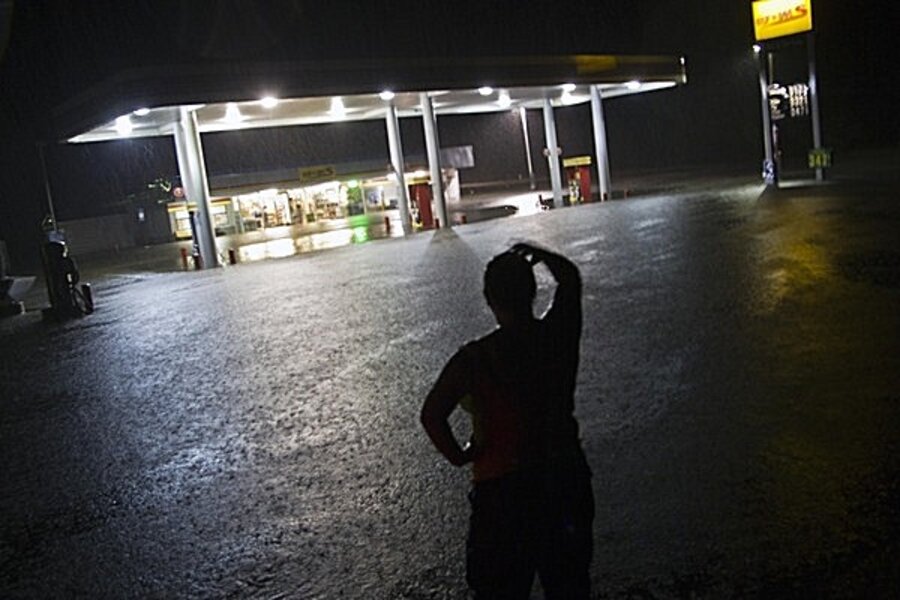Tropical Storm Debby drenches Florida's Gulf Coast
Loading...
| MIAMI
Tropical Storm Debby lashed parts of Florida with driving rains and high winds on Monday, threatening to trigger more flooding and tornadoes as it hovered off the state's northern Gulf of Mexico coast.
With tropical storm-force winds extending outward up to 230 miles (370 km) from its center off the northwest coastal town of Apalachicola late Monday afternoon, forecasters said Debby menaced a broad swath of inland territory with flash flooding from torrential downpours.
Florida Governor Rick Scott declared a state of emergency and a tropical storm warning was in effect along much of the Gulf coastline, from the Florida Panhandle down through the central west coast.
"Because of the broad impact of Tropical Storm Debby, virtually every county in Florida could be affected," Scott said in a statement announcing the statewide emergency.
"Some communities are already grappling with flooding, wind damage and electrical outages," said Scott, who ordered all state agencies, including the
Florida National Guard, to provide any necessary assistance requested by local governments.
The Miami-based National Hurricane Center said Debby, the first named storm of 2012 to move into the Gulf of Mexico, was packing top sustained winds of about 45 miles per hour (72 kph) and forecasters predicted little change in strength over the next couple of days.
Over the weekend, the storm idled about a quarter of U.S. offshore oil and natural gas production in the Gulf of Mexico, based on figures issued by U.S. offshore regulators.
But on Monday, big offshore Gulf of Mexico drillers like BP Plc and Royal Dutch Shell began returning staff to offshore platforms.
Torrential Rainfall
Forecast models show Debby making landfall along the northern Florida Gulf Coast by Thursday. It could dump more than a foot (30 cm) of rain in some areas of the state, with isolated amounts of more than two feet (64 cm) in north Florida, the hurricane center said.
Flash flood warnings were in effect for many areas and the Florida Division of Emergency Management has cautioned that inland flooding is associated with more than half the deaths from tropical cyclones in the United States over the last 30 years.
Steady rainfall spurred by Debby is expected to extend to southern areas of Alabama, Georgia and South Carolina.
Florida officials said the storm has left an estimated 35,000 people without power and forced the closure of a four-mile (six-km) bridge spanning Tampa Bay that connects the city of St. Petersburg with the Bradenton area.
The hurricane center also warned that more tornadoes were possible in parts of Florida and southern Georgia.
On Sunday, Debby spawned twisters that killed a woman, badly injured a child and wrecked homes in central Florida in rural Highlands County, according to an emergency management official.
Florida's Pinellas Country was also hit hard, with flash flooding in some areas and at least 20 houses with roofs that were partially or fully blown off during a tornado-like storm on Sunday.
In Alabama, rescuers continued a search on Monday for a swimmer who is presumed dead after he went missing off the Gulf Coast near Orange Beach on Sunday.
Debby is expected to continue veering away from the U.S. Gulf waters that are home to about 20 percent of U.S. oil and 6 percent of natural gas output. And the Louisiana Offshore Oil Port, which unloads about 1 million barrels per day of U.S. crude oil imports from giant tankers, said it was set to resume operations on Monday, after shutting Sunday due to rough seas.
But U.S. regulators said on Monday that Gulf of Mexico oil and gas operators had shut in 44.1 percent of daily oil and 34.8 percent of daily natural gas production because of Tropical Storm Debby, a near doubling of the oil total from Sunday.
Though Debby's track was still uncertain, the hurricane center said it could re-emerge and gain strength over the western Atlantic Ocean by next weekend.







